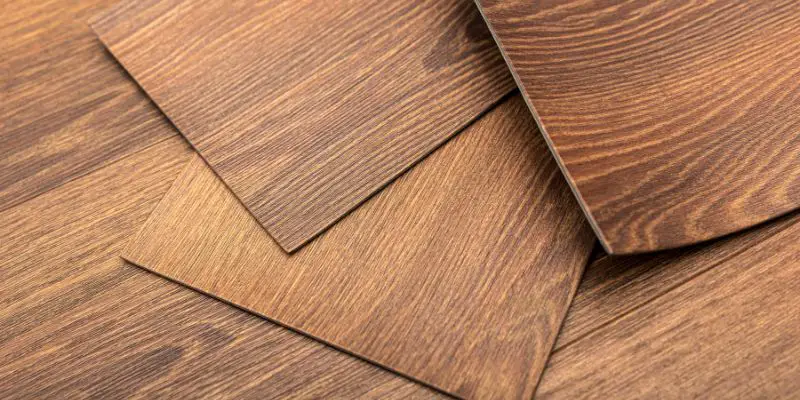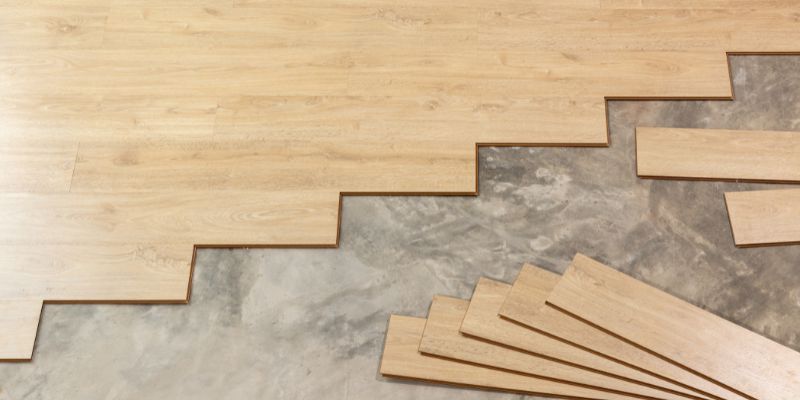Lay vinyl plank flooring in the same direction as your room’s longest wall or the direction of incoming natural light. Vinyl plank flooring should be laid in the same direction as your room’s longest wall or the direction of incoming natural light.
This ensures an aesthetically pleasing and visually elongated appearance. By following this guideline, you create a sense of flow and continuity in the space. It also helps to make the room appear larger and more inviting. Furthermore, laying the vinyl plank flooring in the direction of natural light enhances the overall brightness and openness of the room.
Whether you choose to align with the longest wall or natural light, it is essential to ensure a smooth and level subfloor for a successful installation.
Understanding Vinyl Plank Flooring
When laying vinyl plank flooring, it is important to consider the direction in which you should install it. Understanding the proper way to lay vinyl plank flooring can ensure a seamless and visually appealing result for your space.
What Is Vinyl Plank Flooring?
Vinyl plank flooring is a popular and cost-effective option for homeowners who want the look of hardwood floors without the high price tag. Made from synthetic materials, vinyl plank flooring is designed to mimic the appearance of natural wood. It is composed of multiple layers, including a durable wear layer, a printed design layer, and a waterproof core. This type of flooring is available in a wide range of styles, colors, and textures, allowing you to find the perfect match for your home decor.

Advantages Of Vinyl Plank Flooring
Vinyl plank flooring offers several advantages compared to other types of flooring:
- Durability: Vinyl plank flooring is highly resistant to scratches, dents, and stains. It can withstand heavy foot traffic and is ideal for busy households with children and pets.
- Waterproof: One of the biggest advantages of vinyl plank flooring is its waterproof nature. This makes it suitable for areas prone to moisture, such as kitchens, bathrooms, and basements.
- Easy Maintenance: Vinyl plank flooring is incredibly easy to maintain. Regular sweeping or vacuuming, along with occasional mopping using a mild cleaner, is usually sufficient to keep it looking clean and fresh.
- Cost-effective: Vinyl plank flooring provides the look of real hardwood at a fraction of the cost. It is a budget-friendly option for those who want to update their flooring without breaking the bank.
Types Of Vinyl Plank Flooring
There are different types of vinyl plank flooring available to suit various preferences and requirements:
| Type | Description |
|---|---|
| Luxury Vinyl Plank (LVP) | LVP is the most popular and high-end type of vinyl plank flooring. It is known for its realistic wood-like appearance and superior durability. |
| Rigid Core Vinyl Plank | This type of vinyl plank flooring features a rigid stone-plastic composite (SPC) core, making it highly stable and resistant to impacts. |
| WPC Vinyl Plank | WPC vinyl plank flooring stands for wood-plastic composite. It has a hybrid construction, combining a wood polymer core with a vinyl top layer. |
Determining The Direction For Vinyl Plank Flooring Installation
When it comes to installing vinyl plank flooring, figuring out which direction to lay the planks is an essential consideration. The direction you choose can impact the overall look and feel of your space. In this section, we will explore the factors you should assess when determining the direction for vinyl plank flooring installation, including considerations for choosing the direction, factors to assess in your space, and following the natural light source.
Considerations For Choosing The Direction
Before diving into the installation process, there are several factors you should consider when choosing the direction for your vinyl plank flooring. These factors can help ensure a visually appealing and functional result.
1. Room Shape and Layout
The shape and layout of the room play a significant role in determining the direction of your vinyl plank flooring. A general rule of thumb is to lay the planks parallel to the longest wall in the room. This creates a sense of length and makes the space appear more open. However, if the room is not rectangular or has an irregular shape, you may need to adjust the direction accordingly.
2. Traffic Flow
Another important consideration is the traffic flow within the space. You want to lay the planks in the direction that aligns with the foot traffic patterns. This ensures the flooring is visually appealing and withstands daily wear and tear.
3. Flooring Patterns and Visual Effects
Take into account any patterns or visual effects present in the vinyl plank flooring. Some planks come with natural wood grain patterns or distinct designs. Aligning the planks with the patterns can enhance the overall aesthetic appeal of the space.
Factors To Assess In Your Space
Now that you understand the considerations for choosing the direction of vinyl plank flooring, it’s time to assess your space to make an informed decision. Here are some essential factors to consider:
1. Room Orientation
Start by determining the orientation of the room. Consider which direction the room faces, as this can impact the amount of natural light and heat the space receives. Assessing the room’s orientation can help you decide whether to align the flooring with the length or width of the room.
2. Architectural Features
Take note of any architectural features in the room, such as doorways, windows, and built-in fixtures. These features can influence the direction of the vinyl plank flooring to create a harmonious flow throughout the space.
3. Existing Flooring
If you are replacing old flooring, consider its direction and whether it had a favorable layout. While it’s not necessary to follow the previous floor’s direction, evaluating its layout can provide insights into what worked well or needs improvement.
Following The Natural Light Source
One effective approach to determining the direction for vinyl plank flooring installation is to follow the natural light source in the room. Natural light can significantly impact the ambiance and visual perception of the space. To maximize the effect of natural light, consider the following tips:
- 1. Sunlight Direction: Observe where the sunlight enters the room throughout the day. Aligning the planks perpendicular or parallel to the incoming sunlight can create stunning visual effects.
- 2. Room Brightness: If your room lacks natural light, laying the planks parallel to the windows or light source can help brighten the space and make it feel more spacious.
- 3. Light Reflection: Take into account how light reflects on the flooring. Laying the planks parallel to the main light source can minimize reflections and create a visually calming effect.
In conclusion, determining the direction for vinyl plank flooring installation involves considering various factors such as room shape, traffic flow, and patterns. Additionally, assessing the room’s orientation, architectural features, and existing flooring can provide valuable insights. Lastly, following the natural light source can enhance the overall look and feel of your space. By carefully evaluating these considerations, you can make an informed decision and achieve a visually appealing and functional vinyl plank flooring installation.
Proper Techniques For Installing Vinyl Plank Flooring
Installing vinyl plank flooring can be a great way to add a stylish and durable flooring option to your home. However, to ensure a successful installation that will last for years to come, it is important to follow proper techniques. In this article, we will guide you through the process of preparing the subfloor, determining the starting point for installation, and laying the vinyl planks.
Preparing The Subfloor
Before you begin the installation process, it is crucial to properly prepare the subfloor. A subfloor that is not level or clean can result in uneven flooring and decreased durability. Follow these steps to ensure a smooth and stable surface:
- Start by removing any existing flooring, including carpet, linoleum, or hardwood, and thoroughly clean the subfloor. Make sure to remove any dirt, dust, or debris that could affect the adherence of the new vinyl planks.
- Inspect the subfloor for any damages, such as cracks, holes, or uneven areas. Repair or level the subfloor as necessary. Fill in cracks and holes with a suitable filler, and sand down any high spots to create a level surface.
- Once the subfloor is clean and smooth, it is important to check for moisture. Vinyl plank flooring is not recommended for areas with excessive moisture. Use a moisture meter to measure the moisture content of the subfloor. If it exceeds the manufacturer’s recommendations, address the moisture issue before proceeding with the installation.
Starting Point For Installation
Choosing the right starting point for your vinyl plank flooring installation is essential for achieving a professional-looking result. Here are some tips to help you determine the ideal starting point:
- Consider the main entrance to the room. It is generally recommended to start the installation from the main entrance, creating a seamless look as you enter the space.
- If the room is square or rectangular in shape, you can usually start the installation from one of the walls. This will make the process more straightforward and help maintain consistency throughout the room.
- In irregularly shaped rooms, consider the layout of the space and any focal points, such as a fireplace or a large window. Aligning the planks with these features can create a visually appealing effect.
- Remember to leave an expansion gap along the walls to accommodate for any movement of the vinyl planks. This gap can later be covered with baseboards or molding.
Laying The Vinyl Planks
Now that you have prepared the subfloor and determined the starting point, it’s time to lay the vinyl planks. Follow these steps to ensure a successful installation:
- Refer to the manufacturer’s instructions for the specific installation method recommended for your vinyl plank flooring. Different products may have different requirements, such as glue-down, click-lock, or loose lay installations.
- Start by laying the first row of vinyl planks along the starting wall. Ensure that the planks are snugly fitted against each other and the wall, using spacers to maintain a consistent expansion gap.
- Continue laying the subsequent rows, staggering the seams between the planks for a more natural appearance. Use a tapping block or rubber mallet to gently tap the planks into place, ensuring a tight and secure fit.
- Once all the planks are laid, remove the spacers and install the baseboards or molding to cover the expansion gap, creating a finished look.
By following these proper techniques, you can achieve a beautiful and long-lasting vinyl plank flooring installation that will enhance the aesthetic appeal and value of your home.

Frequently Asked Questions On Which Way Do You Lay Vinyl Plank Flooring
Which Direction Should Vinyl Plank Flooring Be Laid?
Vinyl plank flooring should be laid parallel to the longest wall in the room for a visually pleasing effect.
Is There A Right Or Wrong Way To Lay Vinyl Flooring?
Yes, there is a right way to lay vinyl flooring. Here are 5 guidelines to follow:
1. Measure and prepare the space accurately.
2. Ensure the subfloor is clean, level, and smooth.
3. Use the correct adhesive or interlocking method.
4. Lay the vinyl planks or sheets evenly and securely.
5. Trim and finish the edges properly. Remember, proper installation ensures durability and longevity of the flooring.
Should Tongue Or Groove Go Against The Wall?
The tongue should face towards the wall when installing tongue and groove flooring.
What Is The Best Direction To Lay Laminate Flooring?
The best direction to lay laminate flooring is typically perpendicular to the longest wall. This helps to visually expand the room and offers better stability for the flooring.
Conclusion
Laying vinyl plank flooring requires careful consideration of the room layout, lighting, and overall design aesthetic. By understanding the different installation options and their advantages, you can make an informed decision on which direction to lay your vinyl planks. Ultimately, the goal is to achieve a visually appealing and durable floor that enhances the overall ambiance of your space.
Happy flooring!



2 thoughts on “Which Way Do You Lay Vinyl Plank Flooring? Discover the Best Technique!”